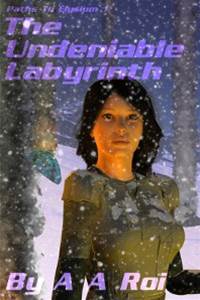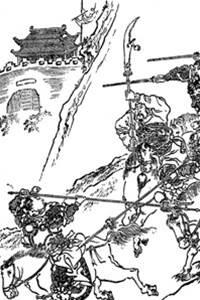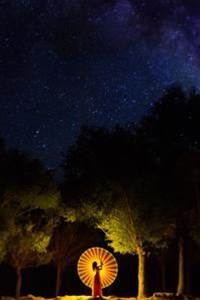《Overseer》20 - Water Games
Advertisement
After passing my time watching Bushtender gleefully work, my attention turned back to the shore colony, which had finally gotten large enough to split into two again. I could see the art of Scalesinger’s songs had finally reached them, and they were just as beautiful underwater as they were above. A few feathered family members, children of mountainside immigrants, looked a bit out of place amidst the mostly gilled colony, but they still got along very well. The gills were very nearly complete as well, as most lizards with gills rarely needed to come to the surface to take in air unless their gills were less developed. The gills that had been near the neck had slowly moved to their back so they could expand and exist next to the lungs. Their chest cavity became a little larger than a land bound lizard’s to accommodate their water lungs. The scales above the undulating gills were hard to protect them, and interlocked with other scales when not in use to hide them. Their air lungs were also capable of deflating to a degree to alleviate pressure from deeper dives, though it took them a moment to regulate themselves when they returned to the surface.
I could also see a couple families break off from the shore colony, deciding to live in the watery realm, spending all day and night under the water. They stayed where light could still penetrate through the water, and were capable of sleep without drowning. They lied amidst the reefs of coral, and the great underwater forests made of towering pillars of kelp. They offered food and protection, and thanks to the heat that lived inside their bodies, they were able to stay warm even in the mildly chilled water.
The adaptation had gone well, and I supposed now I could call the gills complete for my influence over them. Their bodies were compensating well for the watery lifestyle too, their tails were more powerful than land bound lizards, though their legs suffered muscle loss for it. When they took to being bipedal on the shore, they often let their heavier tail trail along the ground, providing a bit more support bracing against the ground, using the strong muscles to keep their bodies upright.
Advertisement
They were proud of their strength in the water, but not so proud that they didn’t accept help on land from their land bound brothers and sisters. They knew where their strengths and weaknesses laid. A fun test of strength had also been developed in the shore lizards, and even those that weren’t fully developed for the water took part. Two lizards would stand facing away from each other, then twist their tails around each other’s, and they would then compete in trying to force their opponent to the ground using their tail strength. The more fast swimming one did, the stronger their tail would get, so underwater racing was also common, particularly among the children who were still developing.
There was a little bitterness for those that lost in feats of strength and speed. Some chose to give up and focus on more domestic achievements, others were encouraged to improve themselves and try again no matter how many times they failed. This was particularly true of the land bound and feathered hybrids, especially the slightly smaller feathered members who had difficulty matching the strength of their water bound family.
Such competition was rare in the forest and mountainside colonies, but they also had far less predators to deal with. For the gilled lizards, there was much more to be fearful of in the water than on land. Up to the reef was generally safe, but if they went further into open water, huge monsters began to appear.
The creatures in the water were strange compared to those on land. Limbs like legs and arms were a rarity, and sharp teeth were commonplace. Distinctions such as herbivore and carnivore didn’t exist in the blue depths, everything ate everything it seemed, even if it was only a piece of something. When a large predator killed large prey, many smaller creatures would come to consume the leftovers. No food was wasted in a place that could be filled with abundance one day and destitute the next.
Advertisement
The calamity had similarly decimated aquatic creatures as it had the shore colonies, and for a time the lizards had to be wary of overfishing, lest they lose an entire source of food. They had to travel for a while inland to get to the greens that provided terrestrial food sources, and some lizards felt it was more trouble than it was worth. Unknowing what they should do, I went on the hunt for them.
What I found was something in great abundance just off the rocky shores of their home. It lay in the kelp forest, or rather, it was the kelp forest. Memories of such sea plenty came not in the form of the gorgeous underwater sanctuary, but in strips of kelp eaten raw, boiled, sometimes dried, and had a healthy source of minerals. To the families that lived among the kelp, I urged them to consume when they were feeling hungry. Although wary at first, they did eventually remove small leaves of the giant plant-like towers and ate them. They did not feel particularly one way or another about the new food, but it did fill their bellies until their next meal.
When their brothers and sisters from the land came into the water, they shared their knowledge of the consumable kelp, and it was taken back to shore to be shared among the rest.
The previously avoided kelp was now harvested and boiled with the salty sea water in crude bowls over fires. Some were eaten right out of the bowls, others laid out on the rocks to dry. It was not as delicious as the fatty and bony fish in the sea, but they found after a time they felt stronger, faster, and they did not fall to disease as easily. I knew of the nutrients in the kelp, and while its flavor left something to be desired, it was both filling and beneficial. Thus kelp became a staple food, and although some young disliked it simply for not having much flavor, they soon came to tolerate it, if not outright enjoy its simplicity.
The dried kelp kept easily enough and could be stored for a long while, making it yet another good that could be traded to the other colonies in return for dried meats and decorations. The dried kelp kept its salty flavor from the water it had lived in, and the tongues of the terrestrial colonies quite liked it.
From the forests on land to the forests under the sea, the lizards lived their lives. Then, were there forests in the skies somewhere, I wondered. Perhaps hidden within the clouds or on some far distant land they could not yet reach. I felt it was finally time to take them there.
19 - Where We Go From Here 21 - The Last Endeavor
-Q&A and Discussion thread-
((Science facts: For those that thought my use of ‘plant-like’ for kelp was in err because it is a plant, it has actually long been proven to be a form of algae, which is neither plant nor animal, but a kingdom of its own (along with fungi, there are actually two kingdoms of algae, all of which fall outside the animal and plant kingdoms). The term seaweed is broad (or as some like to call it now sea vegetable, for more positive connotations) and encompasses both kelp and other algae like kelp. Kelp itself is just a subclass of seaweed. Also, kelp is extremely nutritious, and contains a myriad of minerals, amino acids, and vitamins humans need to survive. I myself am a fan of dried and salted nori, and seaweed wrapped sushi rolls.))
Advertisement
- In Serial110 Chapters

The Undeniable Labyrinth
New Chapter every day! The Legion Consortia Galacium was the greatest civilization that ever existed. It stretched across the galaxy, made up of more than ten thousand distinct human cultures with over two hundred thousand inhabited worlds. Millenia in age it was connected through a system of extra-spacial conduits called The Mirror Maze. It was said that one could walk from one side of the galaxy to the other in less than a hundred steps. It was a marvel of technology, art and peace. Until The Macros came, and in a blink of an eye it was destroyed. The Macros are beings of pure motivated Trinary code. They broke out of The Mirror Maze nearly instantaneously across the Consortia, inhabiting and taking control of the technologies from the most advanced worlds to the least. With no defenses capable of stopping them, they spread throughout the galaxy, destroying interstellar culture after culture. Far from the center of galactic civilization, The Palmyr Century was isolated enough to get advanced word of The Macro invasion. The Palmyr was able to close it’s Mirror Maze gateways to the rest of the Consortia and walled off i’s populated worlds from the threat of The Macros. For more than two hundred and fifty years this protection stood, until it was breached by Althea Ram. Althea Ram, born on the planet Emerald in Palmyr Century was Trinary coding prodigy. This skill lead her to be recruited by a group, the ZAT, an organization engaged in illegal research into Macro code. When found out, the ZAT was eliminated on orders of The First Centurion. Althea escaped with her newly created AI, Dorian. A fugitive, she found herself betrayed time and time again. Ultimately she joined a group organized by the Rian telepath Shirae Valerian. Shirae made a deal with Althea for her own reasons and provided her with a Mirror Port which would allow her to reach the Lost Worlds outside The Palmyr. While she is driven to discover the secrets of The Macros, Althea is still drawn back to The Palmyr by the unfinished business that has defined her. The Promethead is her story. And inside the Undeniable Labyrinth is where the journey begins.
8 203 - In Serial8 Chapters

Kichiro's Rampage
Meet Kichiro, the son of a samurai. A social outcast, he leaves his home with nothing but a musket and a sword, determined to carve himself a niche in a chaotic world of dragons and leviathans. This fiction incorporates LitRPG elements, but it's not set in a VR. It's set in a fantastical world based loosely on East Asia in the 16th and 17th Century, when the Ming Dynasty was on its last legs, with the addition of magic and monsters. I totally stole the stat tables from Exterminatus, the author of Everybody Loves Large Chests, so let me credit him for that. I'm new to writing so please don't hesitate to criticise, and reviews would be greatly appreciated.
8 163 - In Serial9 Chapters

Alien Witch
Zoe Clark makes a deal with the devil. Well, maybe not the devil, but a self-absorbed, narcissistic ghost who would do anything to keep his identity. Thanks to a curse, a prophecy, and an extraterrestrial being, her dying body, and his lost soul become alien-hybrids in order to bring back balance to Earth. Photo by Yash Raut on Unsplash
8 56 - In Serial6 Chapters

Chrono Pact
follow the story of a boy who is devastated after losing his friends in a tragic accident, he was transported to an abstract dimension where he meets Chrona a rogue time skipper. she asked for help. the reason why she chose him was that he has a rare trait called chronic core and the person with this trait can time skips. losing his friends made him feel uneasy so he unreluctantly agrees to help the girl. what does Chrona need help with? what will they learn from the adventures they went on? read this novel to find out chapters may release every monday/wednesday/sunday
8 124 - In Serial46 Chapters

what they wouldn't do | DAREDEVIL
Sarah is a secretary at Orion, a shady company previously owned by Wilson Fisk. When Daredevil begins investigating Orion, Sarah accidentally discovers his true identity, and he's not pleased. Despite her best efforts to avoid him after figuring out who he is, she quickly finds herself on the receiving end of a Daredevil interrogation in a dark alley. Post S1, Eventual Matt/OC.playlist made by @one_mor_winter: https://open.spotify.com/user/callawaysa/playlist/6gzBVduyUSHYi0FfJ91V1j?si=zkaDAzKF&nd=1*** DISCLAIMER: THIS IS A REUPLOAD OF A FANFICTION FROM FANFICTION.NET. I DO NOT CLAIM THIS AS MY OWN. ALL CREDIT GOES TO ORIGINAL AUTHOR!! 💛
8 189 - In Serial5 Chapters

Kamen rider Decade x Wakfu Harem:A rider guardien
Y/N L/N was a normal 17 year old boy who had a happy life In his city but monster destroy his city and killed everyone he loved but that was not going to stop him someone named Tsukasa Kadoya was one of the Kamen rider Members and said it was Y/N turn to become a Kamen rider decade and had to protect someone named Yugo from dying or getting hurt because he had to find his mystery Family of Wakfu
8 177







 Prev Chap
Prev Chap Next Chap
Next Chap Chap List
Chap List
 Boy
Boy Girl
Girl
